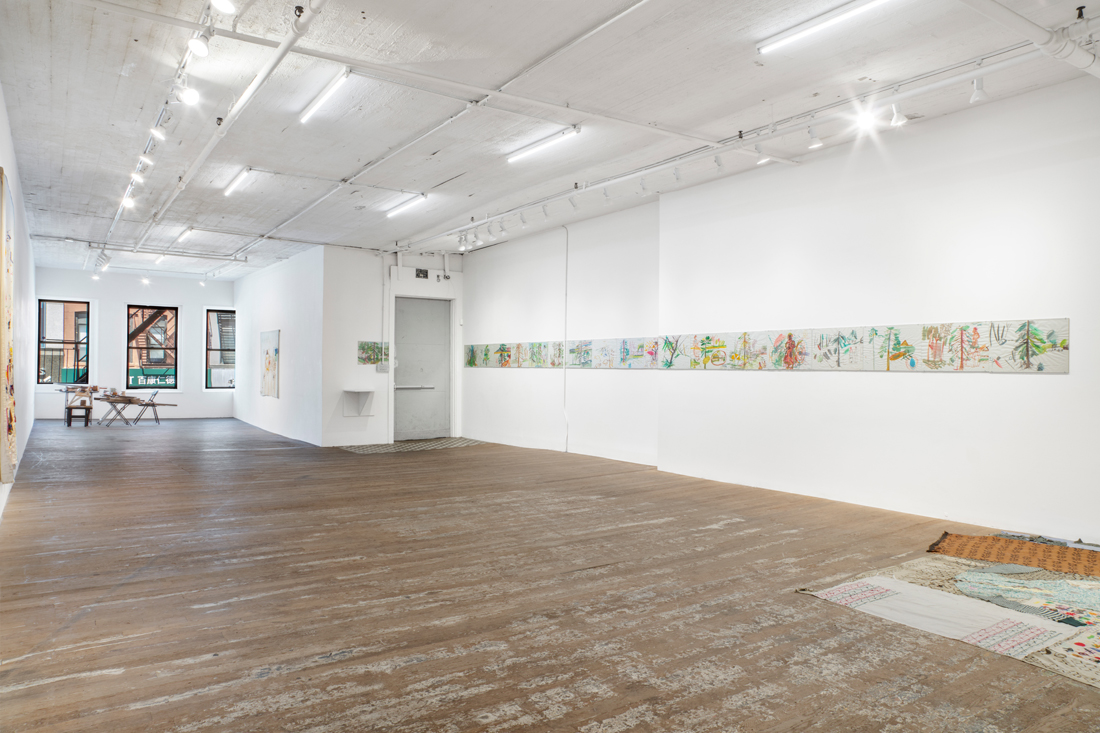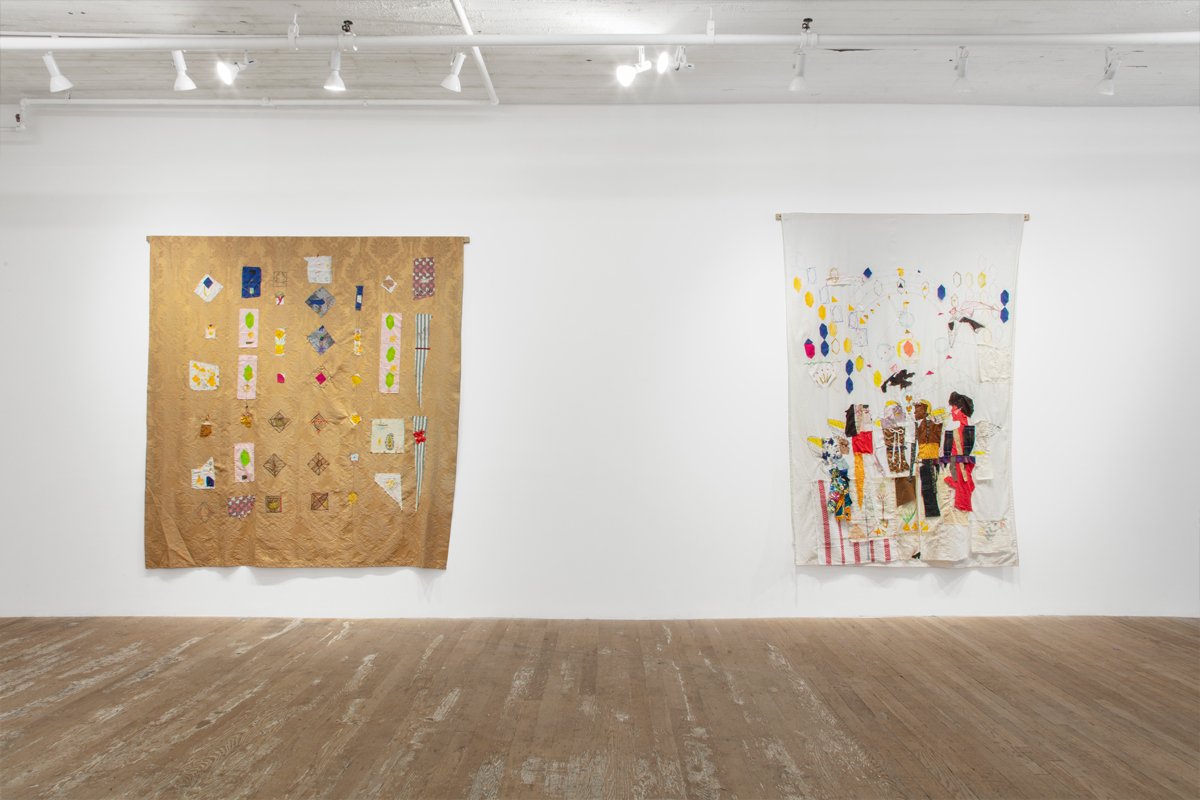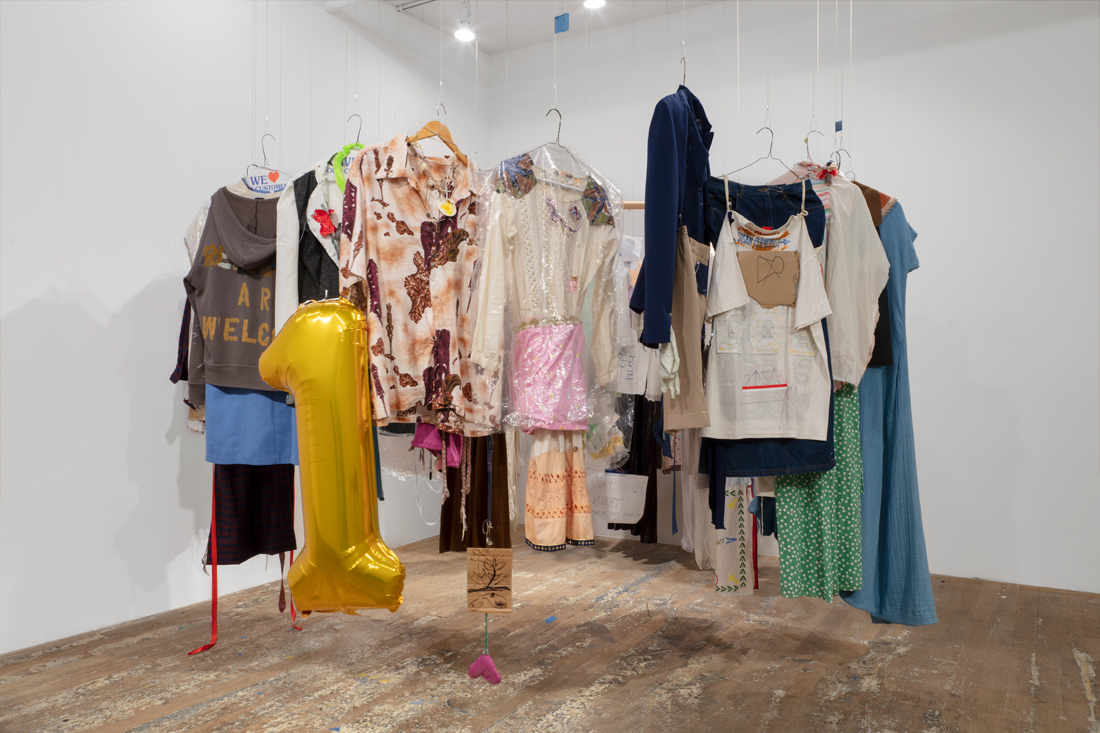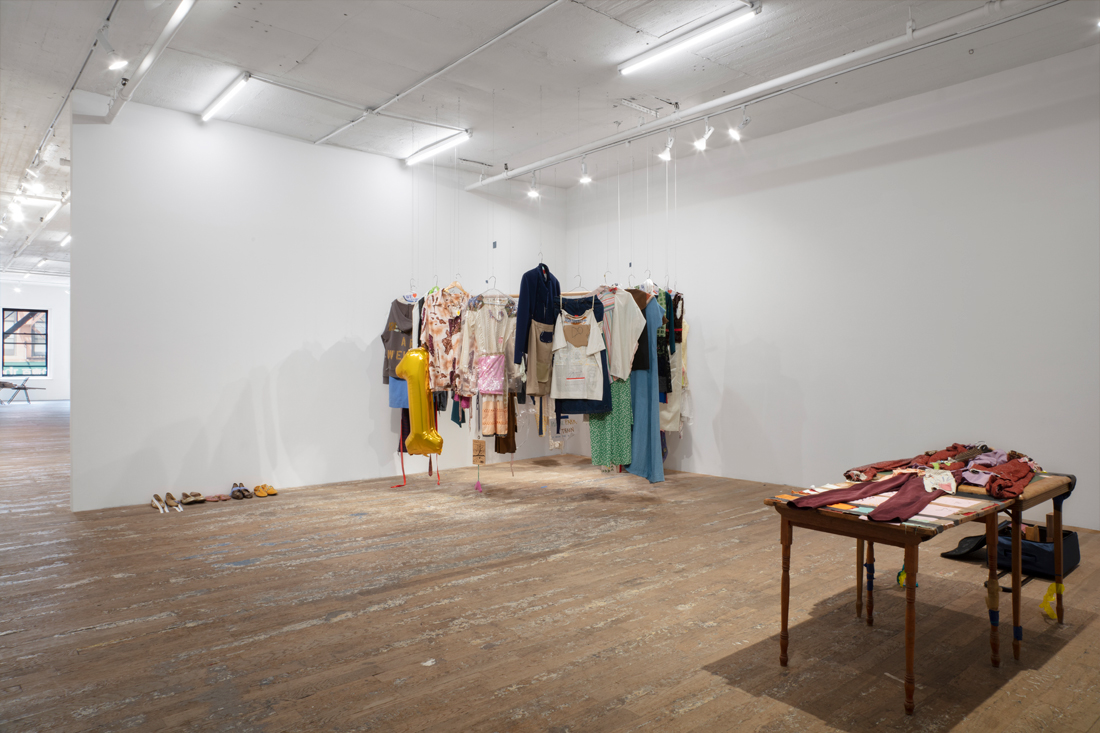 Johanna Fateman
Johanna Fateman
Art, fashion, and collaboration run together in a new show of the legendary designer’s couture costumes, paintings, and installations.

Susan Cianciolo: Light Workers - RUN 15 - Game of Life - (Thank You Pine Trees), installation view. Courtesy the artist and Bridget Donahue. Photo: Gregory Carideo.
Susan Cianciolo: Light Workers - RUN 15 - Game of Life - (Thank You Pine Trees), Bridget Donahue, 99 Bowery, New York City,
through July 13, 2024
• • •
This fall will mark the twenty-ninth anniversary of Susan Cianciolo’s fashion label. Though “fashion label” doesn’t really capture the range of objects created (dolls, films, DIY dress kits, and zines) and events staged (happening-like presentations, conceptual restaurants) under the sign of Run—or RUN, as the New York artist’s morphing, collaborative, sporadic enterprise is often stylized. Her legendary first collection was launched at Andrea Rosen Gallery, at its original Soho location, in 1995, where she staked out a runway with two diagonal lines of red tape on the floor. An oral history published by Vogue in 2017—which begins to address an internet lacuna with regard to Cianciolo’s early career—furnishes details about that production: Bernadette Van-Huy (of the kindred art-and-fashion collective Bernadette Corporation, founded in 1994) cut tank tops from thrifted sweatpants for the occasion, and the show’s first model (actor Julianne Nicholson) carried a switchblade as she walked.

Susan Cianciolo: Light Workers - RUN 15 - Game of Life - (Thank You Pine Trees), installation view. Courtesy the artist and Bridget Donahue. Photo: Gregory Carideo.
The latter, oft-cited anecdote seems worth repeating for those new to Cianciolo’s art; it adds a crucial, maybe surprising, note of threat to a picture of her practice, a body of work characterized by its homespun charm, talismanic power, and—in recent years—a God-is-all spiritual message. Traces of punk insouciance and anti-fashion provocation can be found in her current exhibition, Light Workers - RUN 15 - Game of Life - (Thank You Pine Trees), at Bridget Donahue, if you look for them (in fact, there are costumes from her debut in the mix), but such gestures have mostly given way to the dreamier, more hospitably oppositional tendencies present in Cianciolo’s work from the beginning.

Susan Cianciolo: Light Workers - RUN 15 - Game of Life - (Thank You Pine Trees), installation view. Courtesy the artist and Bridget Donahue. Photo: Gregory Carideo. Pictured: Thank You Pine Trees, 2023–24.
The gallery’s front room feels unusually sparse, with just a handful of things on view, including the arboreal love story Thank You Pine Trees (2023–24)—small, watercolor-and-acrylic works on paper pressed beneath Plexiglas sheets in a long stripe against one wall. Opposite hang two tapestries, made with Cianciolo’s signature, un-precious methods of suturing and appliqué. Balance (2024), a beckoning expanse of rumpled gold brocade about the size of a queen bedspread, is intriguing for its scattered, all-over composition. Irregular geometric scraps, baubles, and tiny drawings are tacked to it with loose stitches, which also serve as lines, articulating polyhedral medallions and mysterious abbreviated figures. Needle and thread are similarly used to draw in Light Workers for the 5th Dimension (2024). This semi-abstract group portrait of sorts, expressively patchworked on a field of white cotton, shows five spiritual seekers ready to enter a new plane of space-time (I think). Cianciolo writes, in her press release, that the scene depicts “light workers in an angelic realm on earth.”

Susan Cianciolo: Light Workers - RUN 15 - Game of Life - (Thank You Pine Trees), installation view. Courtesy the artist and Bridget Donahue. Photo: Gregory Carideo. Pictured, left: Balance, 2024. Right: Light Workers for the 5th Dimension, 2024.
An airy atmosphere is thus appropriate to her subject matter, but there’s another explanation for the emptyish space: room had to be made for the opening’s performance of Run 15 (1995–2024), a packed runway show featuring twenty-five costumes designed over the decades, modeled by an intergenerational group of friends and collaborators. The evening’s looks included one worn by actor Coco Gordon-Moore (whose mother Kim Gordon modeled for Run years ago), a wildly embellished jorts-and-blazer ensemble from Cianciolo’s Run 12 God Is a Jacket collection (as denoted by a drawing safety-pinned to Gordon-Moore’s back). Designer Mike Eckhaus appeared in something like a segmented caftan, his arms pinned to his sides with a length of red ribbon tied in a bow. Artist Diamond Stingily was dressed in a multi-textured white gown with a collage-like cape, one dangling sleeve made from the leg of cargo jeans. Claire McKinney, of the fashion label SC103, was radiant in a tie-front, patch-pocket duster composed of mixed calicos and a lush strawberry print, a red cleaning glove hanging at one wrist. And SoiL Thornton, another artist, walked with a metallic-gold mylar balloon, in the shape of the number one, trailing behind him, attached somehow to the bottom of his shirt.

Susan Cianciolo: Light Workers - RUN 15 - Game of Life - (Thank You Pine Trees), installation view. Courtesy the artist and Bridget Donahue. Photo: Gregory Carideo. Pictured: Run 15, 1995–2024.
Cianciolo’s fabrication processes are famously communal—historically, Run collections were produced in sewing circles and emerged from a cross-pollinating artistic-social scene. (As the painter Rita Ackermann, with whom Cianciolo shared a studio on Canal Street in the early days, recalled, “When she had a fashion show, I would do whatever I could to be useful, and when I had a puppet show she designed couture clothing for my puppets.”) In Run 15, a kind of capsule retrospective, the brilliant, nonprofessional models—or light workers—embody a career-spanning tradition of cooperation and courted synergies.

Susan Cianciolo: Light Workers - RUN 15 - Game of Life - (Thank You Pine Trees), installation view. Courtesy the artist and Bridget Donahue. Photo: Gregory Carideo. Pictured, far right: The New Dawn, 2023–24.
The next day, the looks were back on wire dry-cleaning hangers, their paper wrapping emblazoned with “WE ❤ OUR CUSTOMERS,” echoing the use of text and throwaway materials in the artist’s ensembles. Now, Run 15 exists as an installation. Though it’s the indisputable centerpiece of the exhibition, the main attraction, the exquisitely shambolic display of costumes suspended from the ceiling is neither centered nor foregrounded. It occupies a corner of the gallery’s second room, waiting to be discovered. Given its position, a 360-degree inspection of the group is impossible; and almost any view of an individual piece is partially occluded, too. Peeking through gaps to observe Cianciolo’s construction and detailing, or to clock the handwritten tags that identify a garment’s collection, proves difficult. It seems she means for viewers to take in the objects of this unconventional archive not one by one, or chronologically, but in sum. And, lest this wall-less closet come across as too normal, like “fashion,” another assemblage nearby, The New Dawn (2023–24), functions like a bridge, linking Run 15 to other kinds of work—unwearable compositions, in which clothing and personal effects are part of a visual, sculptural lexicon, and maybe a ritual or contemplative practice. The two-part piece features a carry-on-size roller suitcase filled with painted wooden and cardboard shapes, open, laid flat on the floor, and an effigy or “body” made of textile scraps as well as a pair of pants and a jacket, arranged ceremoniously on a platform papered with childlike drawings. As the artist writes, speaking to the unity of her varied endeavors, “All the works have one plane of purpose coming through as a tangible object for GOD.”

Susan Cianciolo: Light Workers - RUN 15 - Game of Life - (Thank You Pine Trees), installation view. Courtesy the artist and Bridget Donahue. Photo: Gregory Carideo. Pictured: The New Dawn, 2023–24 (detail).
While Cianciolo gained a kind of cult success as a designer for her signature, raw-edged constructivist simplicity and distressed Gunne Sax–style romanticism, in 2001, she disappeared from the fashion industry. She made a comeback, you could say, as an artist, with her 2015 solo show at Bridget Donahue. You could also say, conversely, that for a time, her art had a strange life, with her coveted, conceptual garments hanging on racks at Barney’s, etc.—an experiment that eventually ran its course. The exhibition, and particularly the presentation of Run 15, feels fresh not because its references sync up with current strains of nineties nostalgia, or because it shows Cianciolo was practicing salvage-based couture before upcycling became a thing. The costumes feel timelessly off-trend, totally personal, like labors of love bringing a taste of “It” girl, switchblade glamour to the fifth dimension.
Johanna Fateman is a writer, art critic, and musician in New York.